ZHCS613A December 2011 – June 2014 TPS22929D
PRODUCTION DATA.
7 Specifications
7.1 Absolute Maximum Ratings
over operating free-air temperature range (unless otherwise noted)| MIN | MAX | UNIT | |||
|---|---|---|---|---|---|
| VIN | Input voltage range | –0.3 | 6 | V | |
| VOUT | Output voltage range | –0.3 | 6 | V | |
| VON | Input voltage range | –0.3 | 6 | V | |
| PMAX | Maximum continuous power dissipation at 25°C | 463 | mW | ||
| Maximum continuous power dissipation at 70°C | 254 | ||||
| Maximum continuous power dissipation at 85°C | 185 | ||||
| IMAX | Maximum continuous operating current | 2 | A | ||
| TA | Operating free-air temperature range | –40 | 85 | °C | |
| TJ | Maximum junction temperature | 125 | °C | ||
7.2 Handling Ratings
| MIN | MAX | UNIT | |||
|---|---|---|---|---|---|
| Tstg | Storage temperature range | –65 | 150 | °C | |
| V(ESD) | Electrostatic discharge | Human body model (HBM), per ANSI/ESDA/JEDEC JS-001, all pins(1) | –2 | 2 | kV |
| Charged device model (CDM), per JEDEC specification JESD22-C101, all pins(2) | –1 | 1 | |||
(1) JEDEC document JEP155 states that 500-V HBM allows safe manufacturing with a standard ESD control process. Pins listed as 2 kV may actually have higher performance.
(2) JEDEC document JEP157 states that 250-V CDM allows safe manufacturing with a standard ESD control process. Pins listed as 1 kV may actually have higher performance.
7.3 Recommended Operating Conditions
| MIN | MAX | UNIT | |||
|---|---|---|---|---|---|
| VIN | Input voltage range | 1.4 | 5.5 | V | |
| VON | ON voltage range | 0 | 5.5 | V | |
| VOUT | Output voltage range | VIN | |||
| VIH | High-level input voltage, ON | VIN = 1.4 V to 5.5 V | 1.1 | 5.5 | V |
| VIL | Low-level input voltage, ON | VIN = 3.61 V to 5.5 V | 0.6 | V | |
| VIN = 1.4 V to 3.6 V | 0.4 | V | |||
| CIN | Input Capacitor | 1 (1) | µF | ||
(1) Refer to the application section.
7.4 Thermal Information
| THERMAL METRIC(1) | TPS22929D | UNITS | |
|---|---|---|---|
| DBV | |||
| 6 PINS | |||
| RθJA | Junction-to-ambient thermal resistance | 216 | °C/W |
| RθJCtop | Junction-to-case (top) thermal resistance | 209 | |
| RθJB | Junction-to-board thermal resistance | 131 | |
| ψJT | Junction-to-top characterization parameter | 52 | |
| ψJB | Junction-to-board characterization parameter | 110 | |
(1) For more information about traditional and new thermal metrics, see the IC Package Thermal Metrics application report, SPRA953.
7.5 Electrical Characteristics
VIN = 1.4 V to 5.5 V, TA = –40ºC to 85ºC (unless otherwise noted)| PARAMETER | TEST CONDITIONS | TA | MIN | TYP | MAX | UNIT | |
|---|---|---|---|---|---|---|---|
| IIN | Quiescent current | IOUT = 0, VIN = VON = 5.25 V | Full | 2.2 | 10 | µA | |
| IOUT = 0, VIN = VON = 4.2 V | 2.1 | 7.0 | |||||
| IOUT = 0, VIN = VON = 3.6 V | 2.0 | 7.0 | |||||
| IOUT = 0, VIN = VON = 2.5 V | 1.0 | 5.0 | |||||
| IOUT = 0, VIN = VON = 1.5 V | 0.8 | 5.0 | |||||
| IIN(off) | Off supply current | VON = GND, VOUT = Open, VIN = 5.25 V | Full | 0.8 | 10 | µA | |
| VON = GND, VOUT = Open, VIN = 4.2 V | 0.3 | 7.0 | |||||
| VON = GND, VOUT = Open, VIN = 3.6 V | 0.2 | 7.0 | |||||
| VON = GND, VOUT = Open, VIN = 2.5 V | 0.2 | 5.0 | |||||
| VON = GND, VOUT = Open, VIN = 1.5 V | 0.1 | 5.0 | |||||
| IIN(Leakage) | Leakage current | VON = GND, VOUT = 0, VIN = 5.25 V | Full | 0.8 | 10 | µA | |
| VON = GND, VOUT = 0, VIN = 4.2 V | 0.3 | 7.0 | |||||
| VON = GND, VOUT = 0, VIN = 3.6 V | 0.2 | 7.0 | |||||
| VON = GND, VOUT = 0, VIN = 2.5 V | 0.2 | 5.0 | |||||
| VON = GND, VOUT = 0, VIN = 1.5 V | 0.1 | 5.0 | |||||
| rON | On-resistance | VIN = 5.25 V, IOUT = –200 mA | 25°C | 115 | 150 | mΩ | |
| Full | 175 | ||||||
| VIN = 5.0 V, IOUT = –200 mA | 25°C | 115 | 150 | ||||
| Full | 175 | ||||||
| VIN = 4.2 V, IOUT = –200 mA | 25°C | 115 | 150 | ||||
| Full | 175 | ||||||
| VIN = 3.3 V, IOUT = –200 mA | 25°C | 115 | 150 | ||||
| Full | 175 | ||||||
| VIN = 2.5 V, IOUT = –200 mA | 25°C | 118 | 155 | ||||
| Full | 180 | ||||||
| VIN = 1.5 V, IOUT = –200 mA | 25°C | 129 | 170 | ||||
| Full | 200 | ||||||
| RPD | Output pull down resistance | VIN = 3.3 V, VON = 0, IOUT = 30 mA | 25°C | 150 | 200 | Ω | |
| UVLO | Under voltage lockout | VIN increasing, VON = 3.6 V, IOUT = –100 mA |
Full | 1.4 | V | ||
| VIN decreasing, VON 3.6 V, RL = 10 Ω | 0.50 | ||||||
| ION | ON input leakage current | VON = 1.4 V to 5.25 V or GND | Full | 1 | µA | ||
| VRVP | Reverse Current Voltage Threshold | 77 | mV | ||||
| tDELAY | Reverse Current Response Delay | VIN = 5V | 10 | µs | |||
7.6 Switching Characteristics
| PARAMETER | TEST CONDITION | TPS22929D | UNIT | |
|---|---|---|---|---|
| TYP | ||||
| VIN = 5 V, TA = 25ºC (unless otherwise noted) | ||||
| tON | Turn-ON time | RL = 10 Ω, CL = 0.1 µF | 3315 | µs |
| tOFF | Turn-OFF time | RL = 10 Ω, CL = 0.1 µF | 7.4 | |
| tR | VOUT rise time | RL = 10 Ω, CL = 0.1 µF | 3660 | |
| tF | VOUT fall time | RL = 10 Ω, CL = 0.1 µF | 6.1 | |
| VIN = 3.3 V, TA = 25ºC (unless otherwise noted) | ||||
| tON | Turn-ON time | RL = 10 Ω, CL = 0.1 µF | 4655 | µs |
| tOFF | Turn-OFF time | RL = 10 Ω, CL = 0.1 µF | 9.5 | |
| tR | VOUT rise time | RL = 10 Ω, CL = 0.1 µF | 4150 | |
| tF | VOUT fall time | RL = 10 Ω, CL = 0.1 µF | 3.0 | |
| VIN = 1.5 V, TA = 25ºC (unless otherwise noted) | ||||
| tON | Turn-ON time | RL = 10 Ω, CL = 0.1 µF | 10175 | µs |
| tOFF | Turn-OFF time | RL = 10 Ω, CL = 0.1 µF | 18.3 | |
| tR | VOUT rise time | RL = 10 Ω, CL = 0.1 µF | 7812 | |
| tF | VOUT fall time | RL = 10 Ω, CL = 0.1 µF | 3.0 | |
7.7 Typical Characteristics
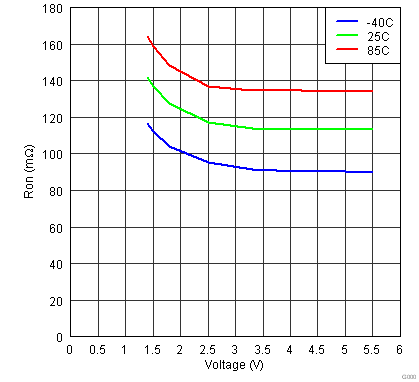 Figure 1. On-State Resistance vs Input Voltage
Figure 1. On-State Resistance vs Input Voltage
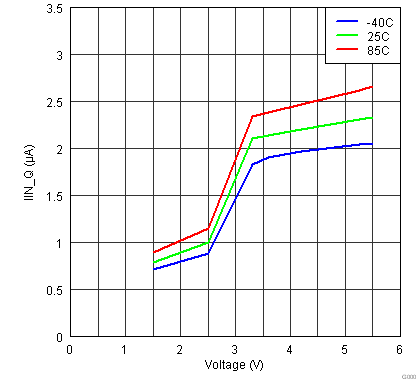 Figure 3. Input Current, Quiescent vs Input Voltage
Figure 3. Input Current, Quiescent vs Input Voltage
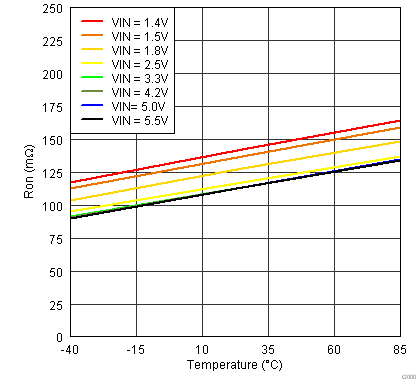 Figure 5. On-State Resistance vs Temperature
Figure 5. On-State Resistance vs Temperature
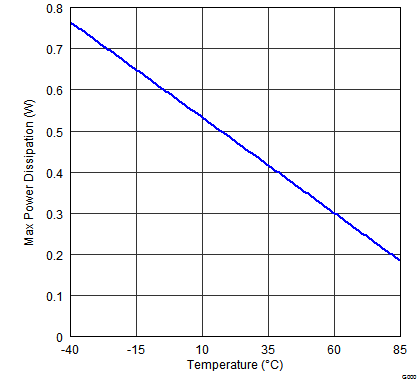 Figure 7. Allowable Power Dissipation
Figure 7. Allowable Power Dissipation
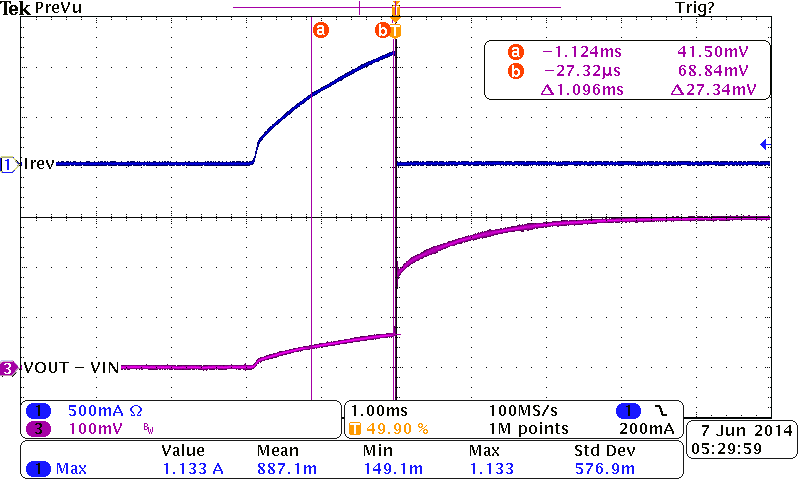 Figure 9. Reverse Current Protection (VIN = 3.0 V, VOUT Ramp up From 3.0 V to 3.3 V)
Figure 9. Reverse Current Protection (VIN = 3.0 V, VOUT Ramp up From 3.0 V to 3.3 V)
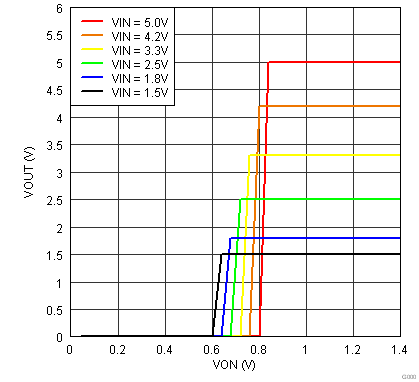 Figure 2. On Input Threshold
Figure 2. On Input Threshold
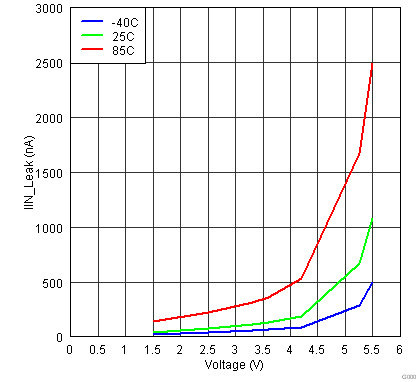 Figure 4. Input Current, Leak vs Input Voltage
Figure 4. Input Current, Leak vs Input Voltage
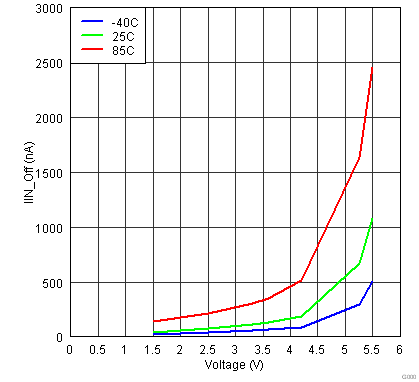 Figure 6. Input Current, Off vs Input Voltage
Figure 6. Input Current, Off vs Input Voltage
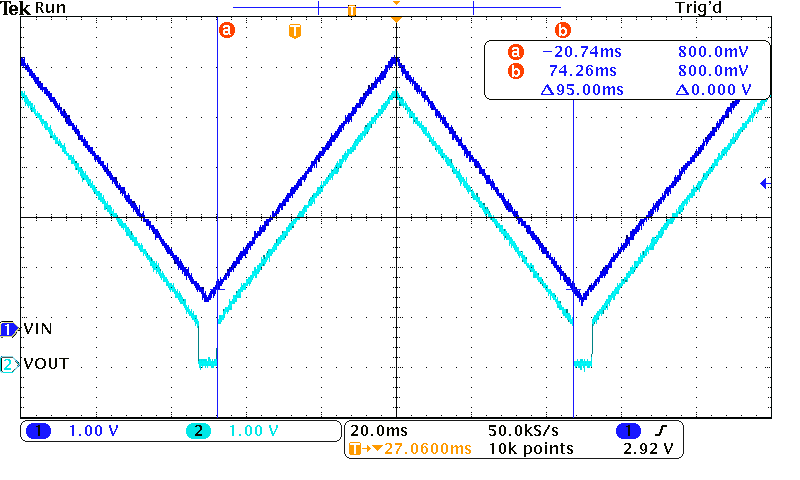
(IOUT = –100mA)
7.7.1 Typical AC Characteristics
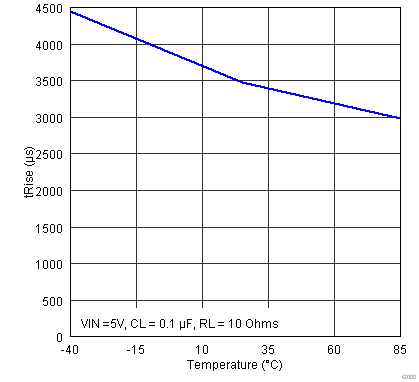 Figure 10. Rise Time vs Temperature
Figure 10. Rise Time vs Temperature
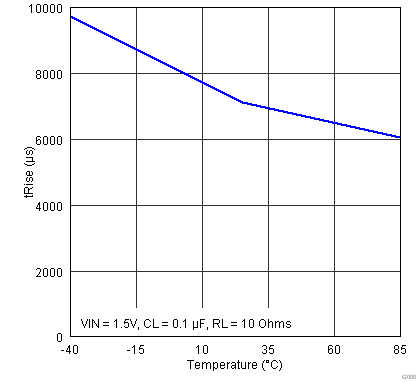 Figure 12. Rise Time vs Temperature
Figure 12. Rise Time vs Temperature
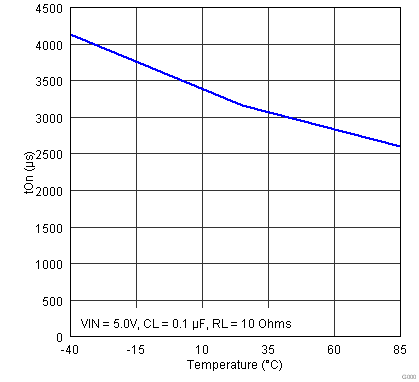 Figure 14. Turn-On Time vs Temperature
Figure 14. Turn-On Time vs Temperature
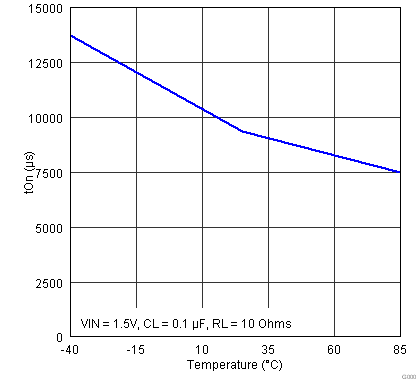 Figure 16. Turn-On Time vs Temperature
Figure 16. Turn-On Time vs Temperature
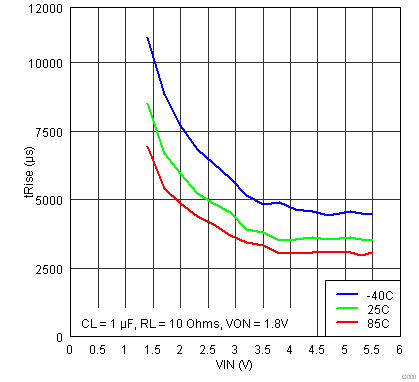 Figure 18. Rise Time vs Input Voltage
Figure 18. Rise Time vs Input Voltage
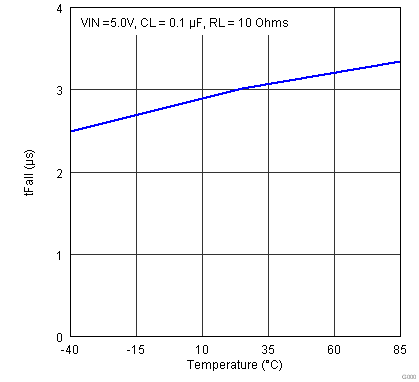 Figure 11. Fall Time vs Temperature
Figure 11. Fall Time vs Temperature
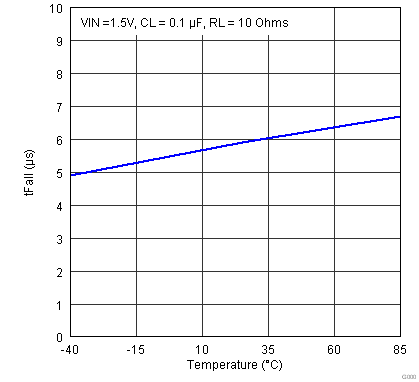 Figure 13. Fall Time vs Temperature
Figure 13. Fall Time vs Temperature
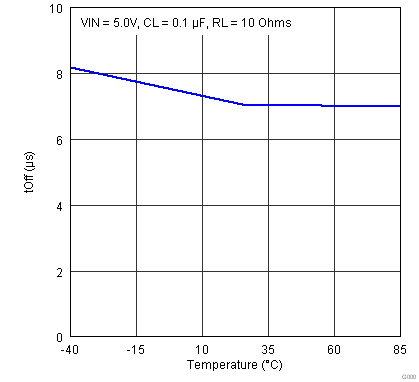 Figure 15. Turn-Off Time vs Temperature
Figure 15. Turn-Off Time vs Temperature
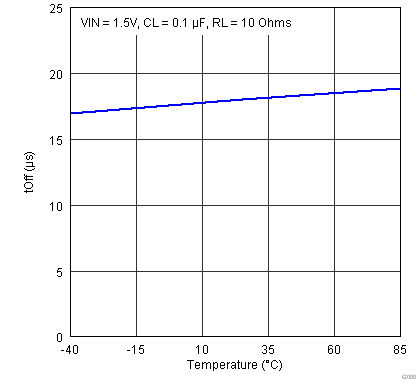 Figure 17. Turn-Off Time vs Temperature
Figure 17. Turn-Off Time vs Temperature
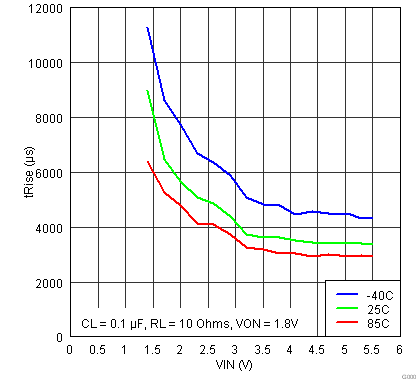 Figure 19. Rise Time vs Input Voltage
Figure 19. Rise Time vs Input Voltage